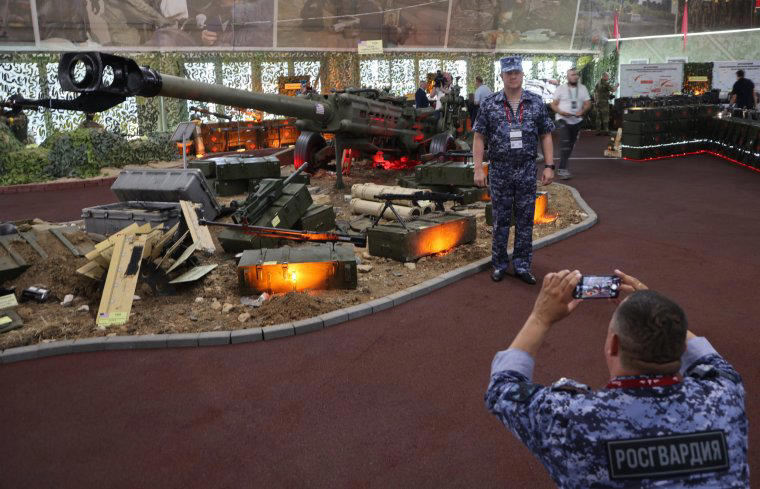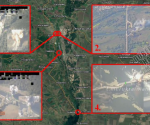Some follow-up concerning the defeat of the Storm Shadow: what Shoigu had to say about it (and about the “counteroffensive”)
The Russian activity in the Kupyansk and Krasny Liman directions is by far the most interesting thing happening right now in any territory of the Ukraine, either controlled by Moscow or Kiev, or in the Black Sea. There’s nothing original and new to add to what has already been written at this site about what the anti-Russian axis forces are trying to do in Zaparozhye, South Donetsk, and around Artyomovsk, and how the Russians respond to them.
To be brief, nevertheless, it looks like the Ukrainian “Spring Offensive”, the much promoted and delayed “counteroffensive” that has been touted since September 2022, along 300 miles (more or less) of its entire front essentially boils down to trying to push through a 5 or 6 mile-long string of settlements from Velyka Novosilka to Urozhainoye and Staromayorskoye in the South Donetsk direction. Everything that was written in the articles The Anti-Russian Axis’ Big Propaganda And Military Defeats In Artyomovsk: Parts one and Two, about the Ukrainians not being able to operate in the open fields, applies†.
No more needs to be written about Ukrainian “counteroffensives”, although there is one point of getting the matter wrong to address, and that is how the author doubted in previous pieces if the Ukrainians could ever muster a “counteroffensive”. Arguably, they still haven’t, if we understand an “offensive” to be a thing more developed than combinations and successions of halted and halting “attack” in two or three 3-5 mile wide local fronts, no matter how many of the latter can be raised.
Moreover, and that being said, if this is to be a follow-up piece to a FBEL article on the defeat in the Special Military Operation inflicted by the Russians upon the UK/French-supplied Storm Shadow cruise missiles, here is a good place to round off on the topic of the Ukrainian “Spring Offensive”, because of the connection between the two explained in said article.
As mentioned, new and original material is not required: instead there will be employment of other sources that will speak for themselves, with only a little bit of annotation in order to bring home the point.
Firstly, the following are extracts taken from the speech of the Russian general and Minister of Defence, Sergei Shoigu, at the XI Moscow Conference on International Security. This is a forum, staged this past week, with a theme of “Realities of Global Security in a Multipolar World”, where over 800 delegates from 76 countries – “heads and representatives of defence agencies, international organizations, and the expert and political science communities”, as Shoigu explains in his welcoming foreword on the Russian Ministry of Defence website – have discussed “problems of global and regional stability, as well as various aspects of security in Asia, Africa, the Middle East”.
The special military operation ended the collective West’s military dominance. Its ability to impose its interests in various regions of the world has been significantly reduced. These changes have increased the role of countries in Asia, Africa and Latin America in the world system, including the use of natural resources for the sovereign development of nations…
Today Russia is confronted not by the Armed Forces of Ukraine, but by the entire collective West, which has recently been joined by individual states in the Asia-Pacific region.
During the special military operation, the Russian Army debunked many myths about the superiority of Western military standards. It became obvious that the use of Western weaponry, supposedly advanced NATO methods of planning operations, methods of troop management and training could not ensure superiority on the battlefield.
Foreign advisers are using Ukrainian soldiers to practice various options for conducting operations using Western weaponry, and Zelensky regime is supplying manpower for these experiments. Foreign advisers do not take into account the level of losses among Ukrainian servicemen.
Despite the full assistance of the West, the AFU has not been able to achieve any results. An example of this is the much-publicised strategic counter-offensive. The skilful actions of the military personnel of the Russian Armed Forces, their coherence and high level of training make it possible to react flexibly to the implementation by Kiev of the plans of its Western handlers.
Preliminary results of the hostilities show that Ukraine’s military resource is almost exhausted. Under the slogan of supporting Kiev, the United States is cleaning up its partners’ military arsenals in various regions of the world, promising favourable supplies of Western-manufactured hardware in return. Essentially, there is a clearing of the market for products of the U.S. military-industrial complex.
However, the partners will have to pay the United States a lot of money for new weapons and agree to limit security sovereignty. An example is Europe, where defence policy is completely subordinated to Washington’s interests…
With regard to the Western-manufactured weapons supplied to Ukraine. I would like to emphasise once again that there is nothing unique or invulnerable to Russian weapons on the battlefield today. In many cases, even Soviet-manufactured hardware is superior in its combat qualities to Western models.
We have objective control data on the destruction of German-manufactured tanks, U.S.–manufactured armoured vehicles, U.K.-manufactured missiles and other weapons systems. We are ready to share assessments of the weaknesses of Western technology with our partners. You can get acquainted with individual samples of trophy weapons at the thematic exhibition in Patriot Park.
The situation is similar with the combat training of troops and the planning of AFU operations. According to statements by a number of high-ranking NATO representatives, more than 75,000 Ukrainian servicemen have been trained to Western standards. Many of them are sent to the front line, captured, and afterwards the servicemen detailed about the methods of NATO training. In most cases, their feedback was negative…
The West, fearing a breakdown of the unipolar world and an open confrontation with a militarily strong adversary, provokes local conflicts around the world. The purpose of such policies is to weaken competitors, maintain control over resources, promote their own rules of life, and counteract the consolidation of dissenters.
Most of Shoigu’s speech involves analysis of the City of London’s (let’s call the “Collective West” by its real name) reaction around the world to multipolarism and its facilitation by a military foe it can’t defeat in open warfare (take especial note, nuclear war doomsayer alternative media geopolitical “experts”), and a little bit representing this has been retained in what has been republished here. It’s important in itself, but subject matter for a different occasion.
What the reader is being asked to take from his speech is germane to the things written about recently hereabouts. Firstly, there’s Shoigu’s assessment of Western military inferiority, and the ways he itemises it (incidentally, this site has for many years been telling its audience about the US military’s crises of readiness). Also, note that he implies that the capability of the NATO bloc is in terminal demise, not just because of a loss of material capability but also because of a restrictive situation caused by vassalage, caused by weaponry delivered to Ukraine being destroyed there by the Russians, and the void therefore created to be filled by the US military industrial complex with its expensive (for the tax-dollar siphoning), vastly inferior product.
Secondly, the “much-publicised strategic counter-offensive” has yielded no results. The Ukrainians are on the verge of exhaustion.
Thirdly, is the issue of the vulnerability of any Western weaponry that the anti-Russian axis cares to present. The Russians can detail – and make this data available to other countries – how they can destroy, for instance, “U.K.-manufactured missiles and other weapons systems”. The Patriot Park that Shoigu mentions is a public space that has temporarily been given over to displaying Western equipment captured in the Ukraine. There are, by some accounts, 800 types of weapon in all on display, everything from rifles to drones, and the star attractions must be the Husky and Saxon armoured personnel carriers from the UK, the American Mastiff “mine-resistant ambush-protected” personnel carrier, the French wheeled “tank”, the AMX-10RCR, the Swedish CV90 Infantry Fighting. Vehicle, and the M777 howitzer – the actual original wunderwaffe.
As for the Storm Shadow, it is, of course, invulnerable according to the Ukrainians and Wikipedia, which is typical of the coverage by UK corporate-media, when it records that “[Ukrainian Minister of Defence] Reznikov said at the end of May that the missiles had hit 100% of their targets, although Russia’s Defence Ministry has claimed to have shot some down”. Conversely, there is no denial – because there is filmed evidence – that the Russians picked up what was for all intents and purposes an intact Storm Shadow that had “crashed in Zaporizhzhia in early July”. If the missile hanging from the ceiling of the indoors section of the Patriot Park exhibition is a Storm Shadow, then it could be this one.
(On the video here, the presenter states that a Storm Shadow is indeed on display).
Indeed, Shoigu’s confidence in the Russian ability to defeat Western weaponry, and his specifically mentioning missiles from the UK in respect of this supports the Russian MoD’s tally of something in the region of 80 Storm Shadow shoot downs. Saying that there has only been “some” is wildly off the mark. The Storm Shadow has been comprehensively defeated.
The other topically current wunderwaffe supplied to Ukraine from the UK is of course the Challenger 2 tanks – all 14 of them. While one can lose count of the number of images there are of defeated German-manufactured Leopard tanks (25 killed) and American Bradley IFVs (21), the Challengers have been notable by their absence. Shoigu can’t talk about Russian experience of destroying these tanks if the UK Government is determined that their weapons reputation survives the conflict without also being specifically debunked – which is what many an observer thinks is the case (helped by the story that the UK Ministry of Defence imposed conditions on how the tank could be used).
However, this is all about to change if Forbes’ man, David Axe, is to be believed. His August 15th piece – ironically published the same day as Shoigu was delivering his speech – claimed that the Challengers would at last be making an appearance on the battlefield as part of what we are given the impression is a new Ukrainian initiative in the Zaparozhye direction. Underneath the cheer, however, is a miserable outlook to be discovered when one has picked through all the fat of admission that the Ukrainian ability to attack in Zaporozhye and South Donetsk has been exhausted.
The Ukrainian air assault forces finally have deployed their most powerful unit. The 2,000-person 82nd Air Assault Brigade, which is stacked with Marder and Stryker fighting vehicles and Challenger 2 tanks, rolled into action around Robotyne, in southern Ukraine’s Zaporizhzhia Oblast, apparently in the last few days…
The 82nd Brigade and its sister air-assault unit, the 46th Brigade, were some of the last major units that the Ukrainian general staff was holding in reserve. In finally sending those formations into battle, the Ukrainians could significantly boost their firepower along one of the main axes of the counteroffensive—the one stretching 50 miles from Russian-occupied Robotyne to occupied Melitopol, just north of the Black Sea coast.
But no brigade can fight forever. When the 46th and 82nd Brigades pull back for rest, reset and repairs, there might not be any equally powerful fresh brigades to fill in for them. The counteroffensive could lose momentum.
The news is both good and bad, therefore, according to Axe. The trouble is, this is not a unique situation, and Axe goes on to tell about the Ukrainian marine corps “which has focused its efforts along the Mokri Yaly River Valley, 50 miles to the east, [and] has deployed all four of its front-line brigades at the same time along a 10-mile-wide sector.”
This is the sector discussed at the top of this page, which Axe sees as having “paid off for Kyiv (sic)”:
The division-size marine force has liberated a chain of settlements on the road to occupied Mariupol, on the Black Sea coast 50 miles to the south…
But the marines eventually will need rest. And it’s not apparent which forces can fill in for them. While Ukraine still has uncommitted territorial and national guard brigades, these formations generally lack the firepower and training that make marine brigades so effective.
Effectively what is being said here is that the Ukrainians are 50 miles from Mariupol in this sector, with everything committed, and they are finished. Remember, this how the whole “Spring Offensive” can be boiled down.
Applying this to the “powerful Ukrainian air-assault force assemble[d] outside [Rabotino]”:
the surge of air-assault troops around Robotyne could result in rapid gains for Kyiv’s forces. The Ukrainians already were probing, and attempting to flank, the Russian garrison in Robotyne. Now they’ve got two more brigades—and especially heavily-armed ones—to bolster their efforts.
But, recall the thematic difficulty: these forces must be rotated, but they are the reserve.
This doesn’t get to the half of the trouble for the anti-Russian axis. Rabotino is about 4 miles south of a settlement called Novodanilovka, which Liveuamap placed within Ukrainian control before June 4th (and the start of the “counteroffensive”). The cost of the Ukrainian marines coming the 5 or 6 miles to Urozhainoye and Staromayorskoye is perhaps outdone in measures of notoriety only by the cost of arriving less than 4 miles to Rabotino. And now, what is being asked of the very last of Ukraine’s best soldiery is not the work that they should be doing. For surely it was the plan to have the 46th and 82nd Brigades, loaded with the best armour as they supposedly are, in a development of attack beyond this first sticking point: to use them to exploit the initial punching through of the first level of Russian resistance.
It’s no wonder that Axe writes about the “counteroffensive” losing momentum when these supposed super-brigades are wasted trying to do what all the other Ukrainian forces which weren’t in reserve failed to do. The “counteroffensive” in this width of front will be over. In fact, because there can be no follow through when the reserves designed to do it are resting in the rear, it means that the “counteroffensive” is already finished.
As further evidence, please consider the following extracts from Russian MoD briefings of the dates shown:
16th August
In Zaporozhye direction, the Russian grouping of forces, supported by army aviation and artillery, repelled two attacks by assault units of the 82nd Air Assault Brigade of the Ukrainian Armed Forces close to Rabotino and Verbovoye (Zaporozhye region).
In addition, two ammunition depots of the 117th Mechanised Brigade of the AFU close to Kirovo (Zaporozhye region) were hit. During the day, the enemy’s losses were up to 170 Ukrainian troops, three armoured fighting vehicles, two motor vehicles, and one U.S.-made M777 artillery system.
17th August
In Zaporozhye direction, units of the Russian grouping of forces, supported by aviation, artillery, and heavy flamethrowers, repelled an enemy attack and inflicted a comprehensive fire defeat on the assault detachments of the 46th AFU Airmobile Brigade close to Rabotino (Zaporozhye region).
The enemy losses totalled up to 195 Ukrainian troops, four Stryker armoured personnel carriers, two infantry fighting vehicles, three motor vehicles, one U.S.-made M777 artillery system, a UK-made FH-70 gun, as well as two Msta-B and one D-20 howitzers.
18th August
The Russian grouping of forces supported by artillery close to Rabotino (Zaporozhye region) repelled two attacks of the enemy and disable one sabotage and reconnaissance unit in Zaporozhye direction.
Up to 195 Ukrainian troops, two infantry fighting vehicles, three motor vehicles, one Polish-made Krab self-propelled artillery system, one U.S.-made M777 artillery system, and one U.K.-made L119 howitzer have been neutralised during the day.
19th August
In Zaporozhye direction, Russian forces, aviation, and artillery repelled an attack launched by units of the 82nd Air Assault Brigade of the AFU Strategic Reserve close to Raborino (sic) (Zaporozhye region).
Up to 190 Ukrainian troops, one armoured fighting vehicle, two motor vehicles, two Polish-made Krab self-propelled artillery systems, as well as one U.S.-made M119 howitzer have been eliminated.
Putting this all together it tells how the 82nd was defeated on day one, the 46th on the second day – losing four of the super-duper Canadian/US Stryker infantry fighting vehicles in the process (pictures of these emitting smoke can be seen on the internet). Day three, and one of Axe’s other less powerful brigades got a kicking, although they were mauled no less awfully than their ubermensch betters of the 82nd, who returned to the fray on day number four.
According to this, then, after four days the legendary and last hope 82nd is already anything up to 365 men down (something like 18% of its starting manpower). The lost equipment count is only a surprise in that tanks do not feature in it. (I am here to tell you that the UK military junta cannot afford the loss of prestige attached to a Challenger tank being destroyed by the Russians. It is almost impossible to envision their actually being put to work and being put at risk).
It only remains for us to remark on the peculiarity of Axe’s opinion, given that he is writing about the coming of the game-changer (at long last), on what the ramifications will be for what is the actual emergent situation:
If the Russians in Robotyne can hold their ground, and endure what is likely to be a major but temporary surge in Ukrainian combat power, they might eventually find themselves in a position to strike back at the Ukrainians—once the surge brigades rotate off the front line without replacement.
This, reader, is what one could call expectation management.
Back in January of this year, the following appeared in the FBEL article, The Russian Offensive:
If the Russians are not fools – and there’s no evidence to suggest they are – Ukrainian plans are going to be accounted for, whether in terms of their being reacted to or negated. The former option is the author’s least preferred, but it is a possibility. However, this time the Ukrainians will not meet a foe who is acting advantageously by retiring in front of them. Russian defences have been built in Zaporozhe, implying the line in the sand. Because of their mobilisation of 300,000, and the consolidation of the front line, the Russians can concentrate in much more force than they have before (it’s all a matter of a simple choice). The Ukrainians will be in danger of finding out how many tanks the Russians really, really have. A counter attack to follow? But we are on that perilous path of speculating about that which can’t be predicted.
This was a paragraph about what would happen if the Russians, rather than aggressively reducing the scope by which it could be executed, let the Ukrainians hatch the plan for which Zaluzhny (now redundant, one way or another) had demanded the provision of “300 tanks, 600-700 infantry fighting vehicles, [and] 500 Howitzers”. Quite clearly it was understood that the Ukrainians would be mullah’ed. The idea that the Russians would then quite swiftly thereafter execute their own forward push was briefly expressed but not allowed any more consideration for.
Axe, perhaps, betrays the fact that his side has not only been thinking about it, but considers it a distinct possibility, and this is why the likes of Stian Jenssen, the chief of staff to the NATO secretary general, Jens Stoltenberg, was lately trialling the concept of Ukraine ceding territory in a deal for peace. Moreover, in reality, if the Washington Post is acting as mouthpiece to US intelligence to state that the Ukrainians won’t achieve the objective of taking Melitopol (50 miles away, again, this time from Rabotino), things are already much grimmer in these people’s outlook than that.
By the way, don’t let anyone tell you, as they do in that Washington Post material alluded to, that the Ukrainians fought their “counteroffensive” differently to that which they had been instructed. This would be damage control, and one can presently see it everywhere. Shoigu, let it be noted, was quite clear about the Ukrainians not being in charge of their own devices, and this is the insight one should put faith in. After all, it is the anti-Russian axis’ ascertainment of the outcome of the “counteroffensive” that is publicly changing, and moving towards the appraisal of Shoigu’s.
† It appears that the official excuse for the failure of the Ukrainian “counteroffensive” will be “minefields”.
Look at this, for instance, from the much mentioned Washington Post material:
The grim assessment [that Ukraine will fail to meet the offensive’s key goal] is based on Russia’s brutal proficiency in defending occupied territory through a phalanx of minefields and trenches, and is likely to prompt finger pointing inside Kyiv (sic) and Western capitals about why a counteroffensive that saw tens of billions of dollars of Western weapons and military equipment fell short of its goals.
As far as the author understands it, the Ukrainians have never reached the first line of prepared Russian defences. If the Ukrainians were coming the cropper against minefields, let us understand properly that it must have been the type that the Russians can create dynamically with remote mine laying equipment. This would explain why the Ukrainians seemingly kept driving unwittingly through spaces that they thought were not trapped. If the reader doesn’t know about this Russian capacity, then it is a fascinating thing to learn about. The Russians can project mines so that a minefield can “pop-up” where it was never suspected to be. These mines can have a shelf-life, so that the space they are in becomes safe. Potentially, an enemy can be made quite confused by this, having to navigate around spaces that don’t need to be, but yet can’t be trusted, and of course by falling victim in spaces where mining was not expected. It should be counted as another aspect of Russian stand-off fire dominance.




















